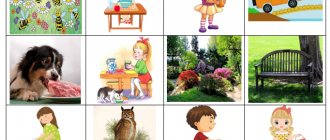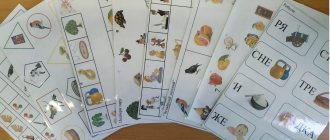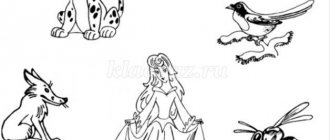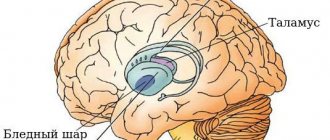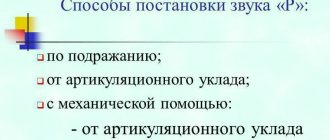Speech hearing
Correct speech of a child is achieved through speech hearing. To pronounce sounds correctly, the child must clearly perceive them by ear.
Determine the location of sounds in a word: at the beginning, middle or end of the word. Hear whether a given sound is hissing or not.
Distinguish sounds against the background of similar sounds:
- In an isolated position
- In syllables
- In words
Expert opinion
Margarita Sergeevna S.
Speech pathologist and speech pathologist with 15 years of experience working in various speech correction centers with children of different ages.
With dysarthria, the production and automation of hissing sounds becomes more complicated and requires more time and individual training.
Reasons for incorrect sound pronunciation
There are several reasons why a baby may not be able to make sounds:
- Short frenulum of the tongue - you will have to cut it, because it does not allow the tongue to rise up, which is necessary for the pronunciation of sibilants;
- High narrow hard palate;
- Abnormal structure of teeth and jaws - gaps between teeth, cleft palate and upper lip;
- Features of the bite: open, deep with protrusion.
In these cases, consultation with an orthodontist is necessary. But in most cases, children simply do not understand how to pronounce the sound correctly or copy the speech of other children, for example in kindergarten. In this case, speech therapy exercises “w” and gymnastics - articulation and breathing - will help.
Sound pronunciation disorders
It is more effective to diagnose and carry out correction of speech disorders in preschoolers.
So that when entering grade 1, a child can clearly pronounce all the sounds of his native language, know their characteristics (hard or soft, voiceless or voiced, stressed or unstressed, paired or unpaired).
Classes for children are conducted in a playful way, step by step, from simple to complex - setting an isolated sound, introducing it into speech in syllables, words, phrases, sentences, text.
In secondary groups of preschool educational institutions, rapid diagnostics are carried out.
In the senior and preparatory groups there are subgroup and individual lessons.
Stage II of work
(conducted as part of the lesson)
Subject . Clarifying the pronunciation of an existing sound or evoking it by imitation. Development of speech breathing, voice strength. Target . To achieve, whenever possible, from each child the correct, long, loud pronunciation of the sound zh. Previous work . The sound sh has been worked out, identical in articulation to the sound zh. Preparatory work . Clarify how the children of the group pronounce the sound z. Prepare a picture of a beetle.
Exercise “The beetle is buzzing”
Brief description The teacher or speech therapist shows the children a picture of a beetle and asks them to remember how in the summer the beetles flew and buzzed at the dacha (they pronounce the sound zhzh for a long time). The teacher draws the children's attention to the position of the lips (rounded and slightly pushed forward), the tongue (the wide tongue is raised towards the tubercles behind the upper teeth), and the presence of a warm air stream coming out of the mouth. Then the teacher says: “Let us remember how the air hissed when it came out of the bursting balloon... What did the voice do when we said the sound w? (“The voice slept, the house was quiet”). Let’s put our hand to the neck and say for a long time: “zhzh...” What is the little voice doing: sleeping or singing songs? (“A voice sings a song.”) Does he sing songs loudly or quietly?” (“The voice sings songs so loudly that the walls of the house shake.”) Then the teacher says that in addition to beetles, bees and flies can buzz, and invites the children to play bees.
Game "Bees Collect Honey"
Brief description Some of the children depict flowers. The teacher puts a wreath on each child’s head from the flowers that he depicts (for one - daisies, for another - cornflowers, etc.). The rest of the children portray bees that collect honey from flowers. The bees fly around the flowers and buzz: “zhzh..” At the teacher’s signal, they fly into the hive (fenced off area). Then the children change roles.
Game "Flies in the Web"
Brief description Some of the children depict a web. They form a circle. Other children, pretending to be flies, buzz: “zhzh...”, running in and out of the circle. At the teacher’s signals, the children depicting the web join hands, and the children in the circle stand in it, the web increases in size. The game continues until all the flies are caught.
Methodical instructions.
The game is best played with subgroups of four to five people. In order for children to correctly pronounce the sound z, it is necessary to monitor the correct position of the lips, tongue, and the presence of a straight exhaled stream of air. Remind you that when the wind rustled in the trees, it rustled quietly; and flies, bees, and beetles buzz loudly: when a sound is pronounced, the voice “sings a song.”
Note : These games can be played outside of class in order to consolidate the pronunciation of the isolated sound z.
Setting the sound
With normal speech development, “hissing” sounds, which include [Ш], [Ж], [Ч], [Ш], should appear in the child’s speech by the age of 4-4.5 years.
[Zh] is a consonant, always hard, sonorous sound of the Russian language.
There are several ways to achieve the result:
- With mechanical assistance
- By showing articulation
- From correct [R]
The use of one or more methods in combination depends on each specific situation.
To solve our problem, it is necessary to perform an appropriate set of articulation and breathing exercises every day.
Don't miss: Sound Sh
Breathing exercises
- "Swing". Take a lying position on your back. One hand is on the stomach and the other on the chest. When you inhale through your nose, your stomach rises; when you exhale through your mouth, your stomach lowers.
Exercise "Swing"
- "Bullets." Fill any small container (mug, glass, small jug) with clean water. Take a cocktail straw. Through it you need to exhale air into the water. Bubbles bursting out with a loud noise will turn the execution into an exciting game.
- "Singing". The vowels [A], [O], [U], [Y] must be sung when answering the question asked. How do the animals moan that came to Dr. Aibolit? "O-O-O-O-O." How does a snow blizzard howl in winter? “U-U-U-U-U-U.” How does the train hum when it sets off? “Y-Y-Y-Y-Y.” How naughty is a baby? "A-A-A-A-A." These chants must be pronounced as long as possible, but with one exhalation.
Articulation gymnastics exercises
- "Fence". Without opening your teeth, smile broadly. Do not strain your facial muscles. Try to hold a smile for 10-15 seconds.
- "Tube". Closed teeth are the main condition. Invite the child to reach out and take a nearby berry with his lips. If performed correctly and repeatedly, the lips will form a “tube”.
- "Broad language" The lips are open, we stick our tongue out of the mouth, and spank it with our lips several times until it becomes wide. We hold it in this position for 10-15 seconds. We calculate the time out loud.
Exercise "Scapula"
- "Shovel". The task is a continuation of the previous one. We place a wide, calm tongue, which we have already learned how to do, on the lower lip. The facial muscles are as relaxed as possible. Hold for 10-15 seconds.
- "Ball Throw" Make a small ball from a piece of cotton wool. Position the tongue as in the “Shovel” exercise. Bring your face closer to the ball and blow on it, trying to “throw” it as far as possible. When performing the task correctly, a distinct [F] should be heard.
- "Nitting." Open your mouth slightly. Slowly stick out your tongue and slowly bite it. Repeat the process several times, sticking your tongue forward and retracting it back. Perform with a smile, tensing your muscles. By saying something rhythmic, the child not only makes the task easier, but also becomes interested in it.
- "Cup". Open your lips and stick your tongue out. Try to bend it into the shape of a cup. It is recommended to perform in front of a mirror.
Don't miss: Dyslexia - what is this diagnosis?
- "Ladder". A more complex version of "Cup". We stick out our tongue and give it the appropriate shape. Raise it to your upper lip and hold it for a few seconds. We transfer to the upper teeth. We hold again. We translate, as if on a “ladder,” for them. We hold. We perform the process in reverse order. We repeat several such descents and ascents.
- "We got dirty with ice cream." Without helping with the lower lip, but only with one tongue, lick the upper lip with a vertical movement (from the nose down). The child must imagine that she has soiled herself with something tasty. For example, ice cream.
- “Brushing our teeth.” We smile and open our mouth wide. The teeth should be clearly visible. We begin to move the tip of the tongue from the inside, first along the upper teeth several times, then along the lower ones. The movements should resemble those of a toothbrush. Try not to move your lower jaw.
Exercise “Brushing your teeth”
- "Ball on the nose." Let's prepare a small ball of cotton wool. We open our mouth slightly. We lightly press the protruding tip of the tongue to the upper lip. By blowing air between your tongue and lip, we try to blow the ball off your nose. The flow should be directed upward.
- "Let's draw." We open our mouth wide, trying to smile. We begin to slowly stroke the palate with the tip of our tongue. The movements should resemble an artist's brush.
- "Mushroom leg" Open your mouth wide. We stick our tongue to the palate. The hypoglossal ligament stretches like a mushroom stalk. Hold this way for several seconds.
- "Umbrella". Let's complicate the previous exercise. Holding your tongue, we close and open your lips, as if opening an umbrella. We repeat several times, trying to open our “umbrella” as wide as possible. The exercise is aimed at stretching the hypoglossal ligament.
- "Buzzing." "Cup" of the tongue inside the mouth. Pull the lips forward a little and round them. The tip of the tongue is to the palate, the edges are pressed against the upper lateral teeth. When trying to pronounce a buzz, the throat begins to tremble.
Speech material for sound automation
Syllables (example):
We take individual syllables - zha, zho, zhe, zhi, zhu. We pronounce them separately several times, as clearly as possible. We make a design of two - zha-zhu, zhu-zhe, zhu-zhu and others. We pronounce it. We complicate it to three - zha-zho-zha, zhu-zho-zha, zhu-zhi-zha.
Don't miss: The easiest ways to make the sound H
The exercise is not about speed, but about clear pronunciation.
Words (example):
We pronounce words and phrases - yellow, live, ice cream, shortbread, live toad, leather jacket and others.
Poems and rhyme (example):
By coming up with a rhyme, we introduce creative subtext into the lesson, which quickly consolidates the previously achieved result.
Prickly - yellow, simpleton - jacket, sea - alive.
Pure sayings (example):
They not only automate the result, but also make the child’s speech clearer in general.
The wife feels sorry for the toad, the yellow yolk fell on the jacket, the heat in the oven is frying hot.
Suggestions (example):
You need to come up with a short sentence for certain words. Additionally, they develop the creative component of the child’s speech.
The yellow leaf circles easily. The boots are very tight.
Examples of homework to reinforce the assignment.
Task No. 1.
Do breathing and articulation exercises for 15-20 minutes every day.
Task No. 2.
Correct pronunciation, complicating the process.
- Hedgehog. Hedgehog - don't touch it. There’s a prickly hedgehog sitting here, don’t touch it with your hand.
- Blazer. The jacket is a simpleton. Whoever put on such a jacket is very fashionable, not a simpleton.
- Buzzing. It buzzes and flies. The bee buzzes and flies home.
Task No. 3.
Perceive by ear. Connect in pairs and, adding a few words, come up with and write down a small sentence. You can simplify the task by offering several cards and the necessary terms or pictures.
Task No. 4.
We clap our hands for each syllable in the spoken words. Ear training exercise.
Yellow, jacket, ice cream, shortbread, buzzing, pulp, toad, life, plaintively, iron, rust.
Speech therapy breathing exercises
With correct articulation of the sound “zh”, a warm air stream passes through the middle of the tongue when the baby exhales air. If the pronunciation is incorrect, this stream does not exist. Therefore, the goal of gymnastics is to teach this to a child.
When performing exercises, you need to watch your body: your shoulders are motionless, your chest does not rise much when you inhale, and when you exhale, it falls moderately. You need to inhale through your mouth, the inhalation is soft and short, the exhalation is slow and smooth. After inhaling, we immediately begin to speak (but while exhaling).
Here are breathing exercises.
Exercise No. 1. Children are asked to blow a paper snowflake off their palm. Whoever flies further, well done.
Exercise No. 2. Take a strong, intermittent exhale, as if extinguishing a candle, and at the same time say “fuuuu.”
Exercise No. 3. Place a bottle with a narrow neck to your lower lip and blow. There should be some noise.
Exercise No. 4. Smile, hide the tip of your tongue behind your lower teeth, and lift the back of your tongue up. Exhale.
